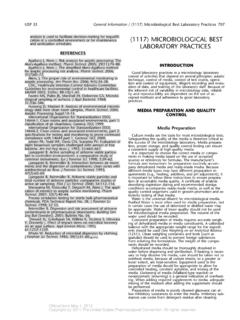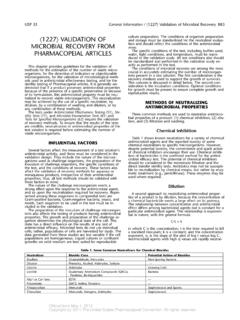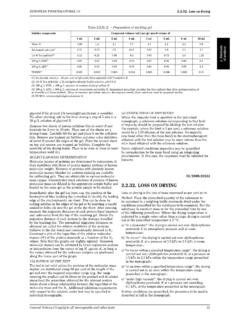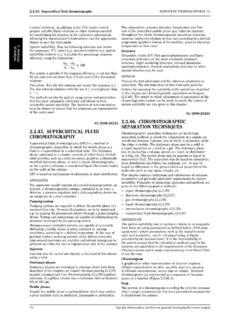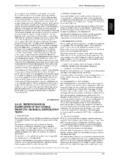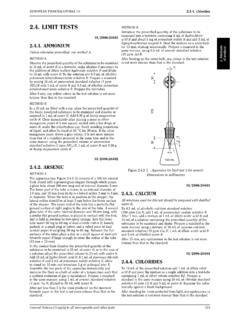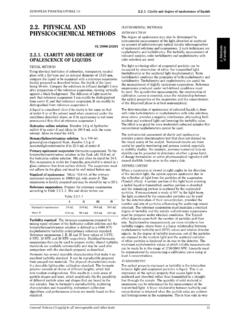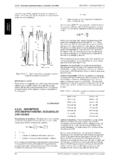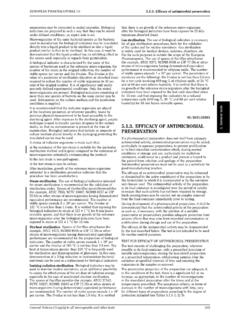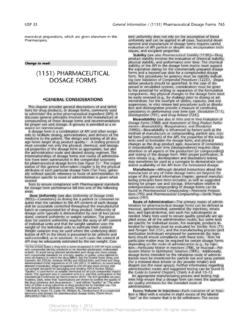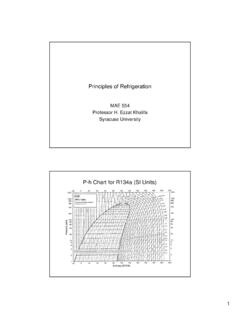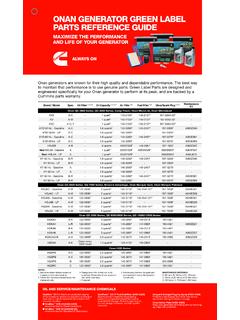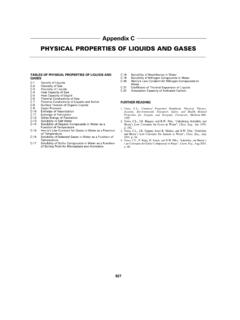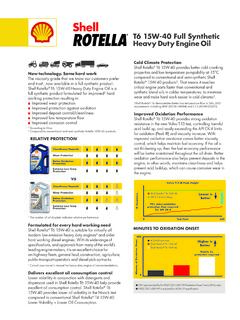Transcription of 2.2.10. VISCOSITY - ROTATING VISCOMETER METHOD
1 VISCOSITY - ROTATING VISCOMETER methodEUROPEAN PHARMACOPOEIA Fill the VISCOMETER through tube (L) with a sufficientquantity of the liquid to be examined, previously brought to20 C unless otherwise prescribed, to fill bulb (A)butensuringthat the level of liquid in bulb (B) is below the exit to ventilationtube (M). Immerse the VISCOMETER in the bath of water at20 C, unless otherwise prescribed, maintain it in theupright position and allow to stand for not less than 30 minto allow the temperature to reach equilibrium. Close tube (M)andraisetheleveloftheliquidintube(N) up to a level about8mmabovemark(E).
2 Keep the liquid at this level by closingtube (N)andopeningtube(M). Open tube (N)andmeasure,with a stop-watch to the nearest one-fifth of a second, the timerequired for the level of the liquid to drop from mark (E)to(F).01/2008 VISCOSITY - ROTATINGVISCOMETER METHODThe principle of the METHOD is to measure the force acting ona rotor (torque) when it rotates at a constant angular velocity(rotational speed) in a liquid. ROTATING viscometers are usedfor measuring the VISCOSITY of Newtonian (shear-independentviscosity) or non-Newtonian liquids (shear dependent viscosityor apparent VISCOSITY ).
3 ROTATING viscometers can be divided in2 groups, namely absolute and relative viscometers. In absoluteviscometers the flow in the measuring geometry is well measurements result in absolute VISCOSITY values, whichcan be compared with any other absolute values. In relativeviscometers the flow in the measuring geometry is not measurements result in relative VISCOSITY values, whichcannot be compared with absolute values or other relative valuesif not determined by the same relative VISCOMETER measuring systems are available for given viscosityranges as well as several rotational following types of instruments are most CYLINDER VISCOMETERS (ABSOLUTEVISCOMETERS)In the concentric cylinder VISCOMETER (coaxial double cylinderviscometer or simply coaxial cylinder VISCOMETER )
4 , the viscosityis determined by placing the liquid in the gap between theinner cylinder and the outer cylinder. VISCOSITY measurementcan be performed by ROTATING the inner cylinder (Searle typeviscometer) or the outer cylinder (Couette type VISCOMETER ),as shown in Figures and , respectively. Forlaminarflow,theviscosity(orapparentvi scosity) expressed inpascal-seconds is given by the following formula:M=torque in newton-metres acting on the cylindersurface, =angular velocity in radians per second,h=height of immersion in metres of the inner cylinderin the liquid medium,Ri=radius in metres of the inner cylinder,Ro=radius in metres of the outer cylinder,k=constant of the apparatus, expressed in radians percubic non-Newtonian liquids it is indispensable to specify theshear stress ( )ortheshearrate( ) at which the VISCOSITY ismeasured.
5 Under narrow gap conditions (conditions satisfiedin absolute viscometers), thereis a proportional relationshipbetweenMand and also between and :where A and B are constants for the instrument and arecalculated from the following expressions: for concentric surface: for cone-plates:M=torque in Newton-metres acting on the cone orcylinder surface, =angular velocity in radians per second,Ri=radius in metres of the inner cylinder,R0=radius in metres of the outer cylinder,R=radius in metres of the cone,h=height of immersion in metres of the inner cylinderin the liquid medium, =angle in radians between the flat disk and the cone, =shear stress in pascals (Pa), =shear rate in reciprocal seconds (s-1).
6 Figure the information section on general monographs (cover pages)EUROPEAN PHARMACOPOEIA VISCOSITY - ROTATING VISCOMETER methodFigure VISCOMETERS (ABSOLUTE VISCOMETERS)In the cone-plate VISCOMETER , the liquid is introduced into thegap between a flat disc and a cone forming a define measurement can be performed by ROTATING the coneor the flat disc, as shown in Figures and ,respectively. For laminar flow, the VISCOSITY (or apparentviscosity) expressed in pascal-seconds is given by the followingformula:M=torque in Newton-metres acting on the flat disc orcone surface, =angular velocity in radians per second, =angle in radians between the flat disc and the cone,R=radius in metres of the cone,k=constant of the apparatus, expressed in radians percubic ,Bof the apparatus (see under concentric cylinderviscometers).
7 Figure VISCOMETERS (RELATIVE VISCOMETERS)In the spindle VISCOMETER , the VISCOSITY is determined by rotatinga spindle (for example, cylinder- or disc-shaped, as shown inFigures and , respectively) immersed in theliquid. Relative values of VISCOSITY (or apparent VISCOSITY ) canbe directly calculated using conversion factors from the scalereading at a given rotational Notices (1) apply to all monographs and other Distillation rangeEUROPEAN PHARMACOPOEIA a general way, the constantkof the apparatus may bedetermined at various speeds of rotation using a certifiedviscometer calibration liquid.
8 The VISCOSITY then correspondsto the formula:METHODM easure the VISCOSITY (or apparent VISCOSITY ) according temperature for measuring the VISCOSITY is indicated inthe monograph. For non-Newtonian systems, the monographindicates the type of VISCOMETER to be used and if absoluteviscometers are used the angular velocity or the shear rate atwhich the measurement is made. If it is impossible to obtain theindicated shear rate exactly, use a shear rate slightly higher anda shear rate slightly lower and relative viscometers the shear rate is not the these conditions, the VISCOSITY of non-Newtonian liquidsdetermined from the previous formula has a relative character,which depends on the type of spindle and the angular velocityas well as the dimensions of the sample container ( = minimum80 mm) and the depth of immersion of the spindle.
9 The valuesobtained are comparable only if the METHOD is carried out underexperimental conditions that are rigorously the DISTILLATION RANGEThe distillation range is the temperature interval, corrected fora pressure of kPa (760 Torr), within which a liquid, or aspecified fraction of a liquid, distils in the following The apparatus (see Figure ) consists of adistillation flask (A), a straight tube condenser (B)whichfitson to the side arm of the flask and a plain-bend adaptor (C)attached to the end of the condenser. The lower end of thecondenser may, alternatively, be bent to replace the thermometer is inserted in the neck of the flask so that theupperendofthemercuryreservoiris5mmlow erthanthejunction of the lower wall of the lateral tube.
10 The thermometeris graduated at C intervals and the scale covers a range ofabout 50 C. During the determination, the flask, including itsneck, is protected from draughts by a suitable Place in the flask (A) and a few pieces of porous material. Collect thedistillate in a 50 mL cylinder graduated in 1 mL. Cooling bycirculating water is essential for liquids distilling below 150 the flask so that boiling is rapidly achieved and note thetemperature at which the first drop of distillate falls into thecylinder. Adjust the heating to give a regular rate of distillationof 2-3 mL/min and note the temperature when the whole orthe prescribed fraction of the liquid, measured at 20 C, the observed temperatures for barometric pressure bymeans of the formula.
